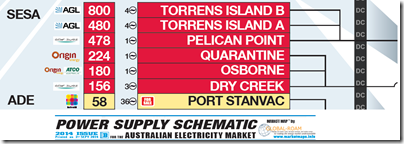Returning from a couple weeks vacation today and catching up on the news, I noted this article last week (and others) about the closure of Torrens Island A station in South Australia.
This follows on from other recent closures such as Redbank in NSW (noted here in November) and Wallerawang in NSW (postulated here in September 2013 and confirmed in August) – and is understandable given the ongoing trend of declining demand, and the growing amount of renewable capacity being added into this oversupplied market with the RET (the underlying reason for the RET Review that never seems to end).
For the benefit of people who can’t easily perform their own analysis, here’s a couple pieces of information that might be of interest:
1) Differentiation between A station and B station
Lifting an excerpt of the South Australian region from our “Power Supply Schematic” Market Map (updated recently), we see that Torrens A (the station that’s closing) is about half the size of the newer and more efficient Torrens B station.
Hence the reduction of 480MW on AGL’s generation capacity is not going to have much impact on the company’s relative size in the market.
2) Trended production at each station
Powering up NEM-Review, we can easily generate the following trended production for each of the stations (overlaid with the monthly average spot price in South Australia, for comparison purposes):
From this chart we can see that Torrens A has consistently been used as a low-capacity peaking station in all but two periods:
(a) At the start of the NEM, when South Australia was undersupplied; and
(b) Through 2010 and 2011 the output also rose slightly.With a total station capacity of 480MW (as shown in the “Power Supply Schematic” excerpt above) we see that many months the output was less than 10% of its capacity.
It’s understandable, then, that the removal of Torrens A won’t do much to add volume to the units at Torrens B that remain operational – though it may well do more to add to prices, at times (like this) when the significant combined capacity of SA’s wind farms are all becalmed.
[ * note that the A station is being mothballed, and that there have been other instances of mothballed plant returning – e.g. Tarong, and Tamar Valley – but this does not seem likely for Torrens Island]
3) Contract for closure – and doomsday predictions
Through 2014 we have seen a number of closure decisions reflecting the oversupply of capacity that threatens to get worse. I’ve previously posted some thoughts about doomsday predictions for security of supply, trying to make sense of some of the complexities.
Quite a coincidence that this Communique from SCER following its 11th December meeting in Adelaide notes that:
“The energy only market design of the National Electricity Market (NEM) has proven to be robust
and efficient, and the Council does not support radical change to the market’s design. Nor does
it support assistance to generators to exit the market. ” (my emphasis added)
Sets the stage for a very interesting 2015….




480MW may not be much in the AGL portfolio, but combined with a couple of other gas fired generators in SA that are rumoured to be planned to be mothballed next year it could get interesting on a hot day with no wind in SA
Good point. We might get to the situation where the wind lovers realise how much they need fossil fuels today.
Note that it’s not an immediate closure. It would coincide with an extra 190 MW of capacity from Victoria when the Heywood inter-connector capacity is increased, a drop in demand with the closure of Holden and other larger users, and an increase in gas prices as the Gladstone LNG plants compete for Moomba supplies. The Torrens Island plant is not a rapid-response gas turbine like Dry Creek, but needs to be kept hot. This makes it less competitive as a true peaking station. The Dry Creek plant has rarely been used recently even on days of high demand.